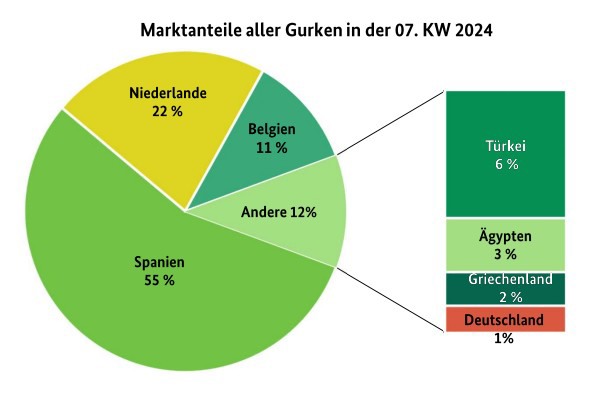Spanish cucumbers formed the foundation of the assortment. Additionally, Dutch offers were available. Belgian deliveries did not reach all markets, while Greek ones were exclusively found in Berlin. Business started off slowly, picking up pace from Ash Wednesday and by Thursday at the latest, interest intensified. Price trends followed a similar pattern, usually dipping at the start of the week before rising again. Overall, supply and demand were balanced, ensuring that needs could always be met according to BLE.

Compared to the previous year, availability from the Benelux countries is high and prices across the segment have accordingly become more favorable. Mini cucumbers were primarily from Spain. Turkish, Dutch, and Egyptian shipments played only a minor role. Additionally, domestic products appeared in Munich, which slightly increased in price due to their convincing quality. Generally, business was rather quiet, so the existing evaluations did not change significantly, apart from the usual fluctuations.
Click here to directly access the complete market and price report.
Apples
Domestic batches were evidently dominant and were mainly complemented by Italian and French imports. Moreover, Dutch, Belgian, and Polish products were processed, which overall played a more supplementary role.
Pears
The presence of Italian goods was evidently decreasing; Abate Fetel and Santa Maria were gradually exiting the market. Other European products were at best playing a complementary role: Dutch, Belgian, and domestic offers only served as an addition.
Grapes
Deliveries from South Africa dominated the scene, with shipments from Peru and Namibia serving as a supplement. A variety of types were available, which, however, occasionally revealed issues with their condition. In these instances, valuations naturally declined.
Oranges
Among the Spanish offers, the presence of later varieties such as Lane Late and Navelate intensified. Navelina lost market share but still played a significant role. Washington Navel from Turkey were priced at €6 per 5-kg package in Hamburg.
Small citrus fruits
Spanish mandarins dominated the scene: Nadorcott were at the forefront, followed by Clemenvilla and Tang Gold. Israeli Orri were next in terms of significance but were occasionally quite expensive, leading traders to order only the necessary quantities. Additionally, Turkish Murcott and Moroccan Nadorcott were available.
Lemons
Spanish Primofiori and Turkish Lama formed the basis of the assortment. Moreover, with the exception of Munich, Egyptian imports were available in all markets, positioned at the lower price limit and only relatively expensive in Cologne.
Bananas
Supply and demand were sufficiently balanced. Therefore, traders rarely had reason to fundamentally modify their existing demands. Only Munich reported slight discounts for the leading brand.
Cauliflower
Leading Spanish and Italian shipments were primarily accompanied by French deliveries. Belgian imports were exclusively available in Cologne, while Turkish imports had completely withdrawn from the market.
Lettuce
Iceberg lettuce came exclusively from Spain. Uneven quality led to a wide price range in Berlin. In Frankfurt, quotations increased as the quality of offers improved. For mixed salads from France and Italy, marketing was relatively calm.
Tomatoes
In the cherry tomatoes segment, Italian shipments took the lead, with Spanish and Dutch offers taking the following spots. In the vine tomatoes segment, extensive quantities of Spanish as well as Turkish, Belgian, and Dutch goods were available.
Bell peppers
Spanish batches dominated the scene and were exclusively available in Cologne. In other markets, Turkish batches were also accessible. In Frankfurt, even yellow items from Turkey appeared, which are usually only sporadically available for a short period.
Source: BLE
